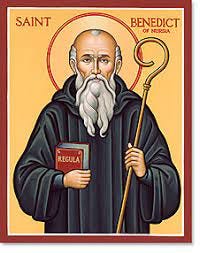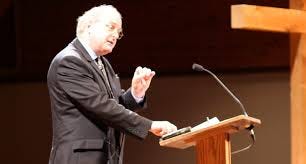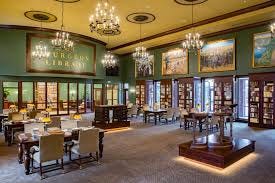The Benedict Option in Kansas City
Preserving the Best of Western Culture During the Looming Dark Ages
In this month’s newsletter I want to share some reflections on Reformed Thomism and the Benedict Option.
Reformed Thomism
I have been reading an excellent PhD thesis recently approved at Midwestern Baptist Theological Seminary written by Timothy Gatewood under Matthew Barrett’s direction and entitled: “Truth Not Served by Human Hands: A Reformed Thomistic Retrieval of Divine Transcendence, Omniscience, and Participatory Truth.” It is a fine piece of systematic theology but the thing I want to note here is the title’s use of the term “Reformed Thomistic” to describe what it seeks to retrieve. The term “Reformed Thomism” is being used increasingly to describe the nature of a Protestant retrieval project that has gained some notice (and notoriety) recently.
This project has a dual focus in that it looks at both medieval scholasticism and post-Reformation Protestant scholasticism. Specifically, as Matthew Barrett explains in his forthcoming book The Reformation as Renewal, the reformers were engaged in the retrieval of the older Augustinian-Thomist strand of medieval scholasticism as a corrective to the voluntarism, univocity, and nominalism of the late medieval scholasticism of Scotus, Ockham, and Biel. This movement known as the via moderna is considered by many to be the deep roots of Western modernity. This approach portrays the Reformation in a new light as a retrieval of catholic orthodoxy rather than as a sectarian attempt to start over with nothing but the Bible. The radicals did that but not the magisterial reformers.
I first encountered the term “Reformed Thomism” in a book by Scott Swain where he wrote of John Webster: “John is the supreme contemporary example of dogmatic theology in a (shall we call it?) Reformed and Thomistic key.” (The God of the Gospel: Robert Jenson’s Trinitarian Theology, p. 7).
I recall Dale Dawson and I having lunch with John somewhere around 2010 and asking him what was up with a recent essay he wrote that cited Thomas Aquinas in almost all its footnotes. (I forget exactly which essay it was - it might have been “Principles of Systematic Theology,” which was first published in IJST in 2009 and can now be found in The Domain of the Word.) I’ll never forget his reply: “It’s just so clear, so clear.” In his late period, John Webster was engaged in the retrieval of “Reformed Thomism” and he clearly pointed us back to Thomas and the Protestant scholastic critical appropriation of Thomas.
Now a new generation of younger scholars is rising to meet the challenge of discovering resources for twenty-first century theology in the pre-Enlightenment past, specifically in the early Protestant recovery of the Augustinian-Thomist tradition that faithfully preserved the Nicene and Chalcedonian heritage of the early church. Midwestern currently serves as a home base for many of them and a hub for many more. It is heartening to see.
The term “Christian Platonism” is the best historical description of the metaphysics taught by the early church fathers and it comes to its apogee in Augustine. Thomism is a species of the genus Christian Platonism. Thomas was basically an Augustinian who taught a participatory metaphysics but also integrated the best of Aristotelian philosophy (mainly the act-potency distinction) into his Christian Platonist framework of exit and return. The term “classical realism” describes the realism at the heart of this whole tradition (Justin Martyr to Thomas Aquinas) and distinguishes it from both the critical realism and the anti-realism of the post-Kantian period.
In modernity, we see extreme nominalism (Hume), several varieties of less extreme nominalism, and constructivism of many kinds culminating in the nihilistic thought of the French deconstructionists. Many conservative Protestants try to negotiate terms with Kantianism by trying to formulate a “critical realism” that they hope can successfully resist the acids of modernity. Many of us today, however, judge this attempt to come to terms with Kant to be a failure and advocate going behind Kant to classical realism of one sort or another as a starting point for twenty-first century theology. The Reformed Thomist project follows this strategy.
The Benedict Option
I had the privilege of co-teaching a PhD seminar on God and Creation with Matthew Barrett at Midwestern in late November - early December. It was a joy to interact with some great students.
I spent a week in Kansas City interacting with various faculty and students and visiting Emmaus Church on Sunday. I had lunch with Thomas Kidd, who is an outstanding historian, and Sam Bierig, who is Dean at Spurgeon’s College, the undergraduate college at Midwestern. Both the president, Jason K. Allen, and the provost, Jason Duesing, graciously took time to welcome my wife Bonnie and me. We attended a Christmas concert put on by the music department and we got a private tour of the magnificent Spurgeon Library.
The Sword and Trowel bookstore is the best one I have seen in years - a large number of substantial books and very little fluff. We also experienced authentic Kansas City bar-b-que! We had dinner with the Barretts, who homeschool three of their children while the oldest has just started high school at a classical school.
Now, I don’t want to insult the mid-West, but one can’t help but notice that it is not exactly New York City. In fact, coastal elites tend to think of it condescendingly as “fly-over country.” But in my opinion it is the kind of place where the best of Western culture still flourishes and probably is going to survive the longest.
What I witnessed in Kansas City was a full-orbed retrieval of historic, Christian orthodoxy at all levels from K-12 education to the local church to college to seminary to doctoral programs. Strong families, theologically orthodox churches, Christian education at all levels and the influence of a major institution (Midwestern) with its laser like focus on the church cohere together to form the contemporary equivalent of a medieval Benedictine monastery with a little village clustered around it. It is no Utopia and no one is making extravagant claims for it as the realization of the kingdom of God. But it is nonetheless a geographically-based community built around a vision of the common good that has deep roots in the history of Christendom. These days such a community is hardly to be taken for granted, especially by a visitor from post-Christian Canada.
Rod Dreher’s 2017 book, The Benedict Option: A Strategy for Christians in a Post-Christian Nation, is concerned with the question of what Christians can and should do after losing the culture wars to a resurgent neo-paganism allied with post-Christian nihilism. Building on the earlier insights of Alasdair MacIntyre’s, After Virtue, Dreher seeks wisdom from the Benedictine response to the “Dark Ages” for today. MacIntyre argued that modern ethics is dominated by an emotivism that leads to an inability to resolve clashes of values except by coercion and violence. He therefore suggested that classical virtue ethics must be preserved by an underground movement until the wider culture is ready to embrace it again. This act of cultural preservation cannot be only intellectual; it must be done by a community of virtue. Perennial wisdom never becomes obsolete; various cultures just render themselves incapable of recognizing it as they decline into decadence. But just as cultures fall, so cultures also rise and history is full of examples of both. As Augustine realized in middle age, the path to the kingdom of God is a winding one with hills and valleys as history unfolds according to Divine Providence. Therefore, Christians are not permitted to fall into despair, which is an act of unfaith even in the face of anti-culture. Conserving the riches of the past comes naturally to Christians and at this stage of history we have much to conserve.
As Dreher documents, modern culture is destroying itself. Philip Rieff’s idea of “anti-culture” is the only way to understand movements like transgenderism, attacks on the nuclear family, and the cancelation of great art, literature, and architecture in favour of blasphemous, dull, lewd garbage. In such a situation, the great need of the hour is not to accommodate to this anti-culture, (God forbid), but to concentrate on building an alternative culture wherever possible.
This is what I saw in Kansas City. It is a new center; it is literally the geographical centre of the United States but metaphorically the cultural center of the future of American civilization. As the coastal elites continue to ransack, undermine, and destroy the riches of our intellectual, religious, artistic, and political heritage, traditional culture must retreat to the margins, which will in time become the new center when the ravaged older center has collapsed.
Conclusion
Culture and theology go together. Theology is contemplation of God and such contemplation leads to wisdom, which works itself out in our discipleship in various culture-impacting ways. The recovery of classically orthodox theology is worthwhile for its own sake, but it has salutary side-benefits for individuals, families, and communities. The monks of the first Dark Ages were primarily concerned with saving their own souls and worshipping God. Yet, they - without quite realizing what they were doing - also managed to save classical civilization and learning. It happened before and it is happening again.





